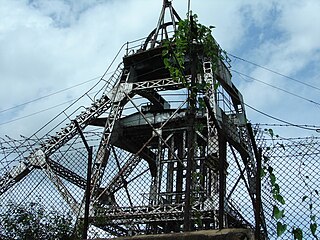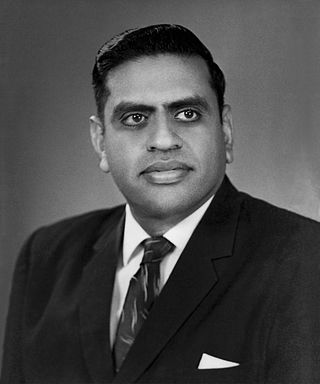
Homi Jehangir Bhabha, FNI, FASc, FRS(30 October 1909 to 24 January 1966) was an Indian nuclear physicist who is widely credited as the "father of the Indian nuclear programme". He was the founding director and professor of physics at the Tata Institute of Fundamental Research (TIFR), as well as the founding director of the Atomic Energy Establishment, Trombay (AEET) which was renamed the Bhabha Atomic Research Centre in his honour. TIFR and AEET served as the cornerstone to the Indian nuclear energy and weapons programme. He was the first chairman of the Indian Atomic Energy Commission and secretary of the Department of Atomic Energy. By supporting space science projects which initially derived their funding from the AEC, he played an important role in the birth of the Indian space programme.

Tata Institute of Fundamental Research (TIFR) is an Indian Research Institute under the Department of Atomic Energy of the Government of India. It is a public deemed university located at Navy Nagar, Colaba in Mumbai. It also has campus in Bangalore, International Centre for Theoretical Sciences (ICTS), and an affiliated campus in Serilingampally near Hyderabad. TIFR conducts research primarily in the natural sciences, the biological sciences and theoretical computer science.

Mambillikalathil Govind Kumar Menon also known as M. G. K. Menon, was a physicist and policy maker from India. He had a prominent role in the development of science and technology in India over four decades. One of his most important contributions was nurturing the Tata Institute of Fundamental Research, Mumbai, which his mentor Homi J. Bhabha founded in 1945.

The TIFR Centre for Applicable Mathematics is part of the School of Mathematics of the Tata Institute of Fundamental Research.

Homi Bhabha Centre for Science Education (HBCSE) is a National Centre of the Tata Institute of Fundamental Research (TIFR), Mumbai, India. The broad goals of the institute are to promote equity and excellence in science and mathematics education from primary school to undergraduate college level, and encourage the growth of scientific literacy in the country. To these ends it carries out a wide spectrum of inter-related activities, which may be viewed under three broad categories:

Piara Singh Gill was an Indian nuclear physicist and a pioneer in cosmic ray nuclear physics. He was the first Director of Central Scientific Instruments Organisation (CSIO) of India. He was research fellow of University of Chicago (1940). He was research Professorship fellow of Tata Institute of Fundamental Research (TIFR) (1947), Officer-on-Special Duty (OSD) with the Atomic Energy Commission in New Delhi. Professor and head of the Department of Physics at Aligarh University (1949), Director of Central Scientific Instruments Organization (CSIO) (1959) and Professor Emeritus at Punjab Agricultural University (1971).

The Kolar Gold Fields (KGF), located in the Kolar district of the state of Karnataka, India, are a set of defunct gold mines known for the neutrino particle experiments and unusual observations that took place there starting in 1960. The experiments ended with the closing of the mine in 1992.

India-based Neutrino Observatory (INO) is a particle physics research project under construction to primarily study atmospheric neutrinos in a 1,200 meters (3,900 ft) deep cave under INO Peak near Theni, Tamil Nadu, India. This project is notable in that it is anticipated to provide a precise measurement of neutrino mixing parameters. The project is a multi-institute collaboration and one of the biggest experimental particle physics projects undertaken in India.
Spenta R. Wadia is an Indian theoretical physicist with research interests in elementary particle physics, quantum field theory and statistical physics, string theory and quantum gravity. His other scientific interests are in complex systems including cross-disciplinary biology. He is a recipient of the 2004 TWAS Prize in Physics; the 1995 Physics Prize of the International Centre for Theoretical Physics (ICTP); and the J. C. Bose Fellowship of the Govt of India. He is an elected member of TWAS, and a Fellow of all the Science Academies of India. In 2024, he was elected to the American Academy of Arts and Sciences, one of the United States' oldest and most prestigious scholarly societies.

Alladi Ramakrishnan was an Indian physicist and the founder of the Institute of Mathematical Sciences (Matscience) in Chennai. He made contributions to stochastic process, particle physics, algebra of matrices, special theory of relativity and quantum mechanics.
Ranjan Roy Daniel was an Indian Nagercoil born physicist who worked in the fields of cosmic rays and space physics, and remained Director Chairman of Tata Institute of Fundamental Research. He also served as an advisor to the prime minister of India, Indira Gandhi in 1976. He worked in the field of cosmic rays with Homi Jehangir Bhabha for 23 years.
Shashikumar Madhusudan Chitre FNA, FASc, FNASc, FRAS was an Indian mathematician and astrophysicist, known for his research in Astronomy and Astrophysics. The Government of India honored him, in 2012, with Padma Bhushan, the third highest civilian award, for his services to the sciences.
Jayashree Ramadas is an Indian educationist. She was the Centre Director (2011–2016) of Homi Bhabha Centre for Science Education (HBCSE), a National Centre of the Tata Institute of Fundamental Research (TIFR) in Mumbai, India. In her capacity as a professor she teaches graduate courses related to cognition and science education. She is also a member of the International Union of Pure and Applied Physics and International Committee on Physics Education. Ramadas was appointed Dean, HBCSE, in November, 2008, and in June 2011, was appointed the Centre Director. She is currently Professor at the TIFR Centre for Interdisciplinary Studies, Hyderabad.
Ramanath Cowsik is an Indian astrophysicist and the James S. McDonnell Professor of Space Sciences at Washington University in St. Louis. He is considered by many as the father of astroparticle physics. A recipient of the Shanti Swarup Bhatnagar Prize, Cowsik was honored by the Government of India, in 2002, with the fourth highest Indian civilian award of Padma Shri
Bernard Peters(born Bernhard Pietrowski in 1910 in Posen, Germany - February 2, 1993 in Copenhagen) was a nuclear physicist, with a specialty in cosmic radiation. He was a recipient of the Padma Bhushan, the third highest Indian civilian award.
Virendra Singh is an Indian theoretical physicist and a former C. V. Raman chair professor and director of the Tata Institute of Fundamental Research (TIFR). Known for his research in high energy physics, Singh is an elected fellow of all the three major Indian science academies - Indian National Science Academy, Indian Academy of Sciences and National Academy of Sciences, India as well as The World Academy of Sciences. The Council of Scientific and Industrial Research, the apex agency of the Government of India for scientific research, awarded him the Shanti Swarup Bhatnagar Prize for Science and Technology, one of the highest Indian science awards, for his contributions to Physical Sciences in 1973.
The Joint Entrance Screening Test (JEST) is a national entrance test in physics and theoretical computer science conducted annually in India. The test is utilised by various Indian public research institutes to shortlist candidates for admission to PhD and Integrated PhD programmes with fellowships in theoretical computer science and areas in physics. JEST has been recognised as a National Eligibility Test (NET) by the Science and Engineering Research Board (SERB).
Varun Bhisham Sahni is an Indian theoretical physicist, astrophysicist and a Distinguished Professor at the Inter-University Centre for Astronomy and Astrophysics. Known for his research on cosmology, Sahni is an elected fellow of all the three major Indian science academies viz. Indian Academy of Sciences, Indian National Science Academy and National Academy of Sciences, India. The Council of Scientific and Industrial Research, the apex agency of the Government of India for scientific research, awarded him the Shanti Swarup Bhatnagar Prize for Science and Technology, one of the highest Indian science awards, for his contributions to physical sciences in 2000.
Arvind Kumar is an Indian physicist and educationist. He was Centre Director, Homi Bhabha Centre for Science Education, Mumbai, during the period 1994-2008. For his contributions in the field of science education, he was awarded the Padma Shri, India's fourth highest civilian honour, in 2010. He is a Fellow of the National Academy of Sciences, India, and is the recipient of several other honours and awards, including the TWAS regional award for Science Education.

Bibha Chowdhuri was an Indian particle physicist known for her investigations into cosmic rays. Working with D M Bose, she utilized photographic nuclear emulsion to become the first to detect and identify mesons. The IAU named the star HD 86081 Bibha, after her.












